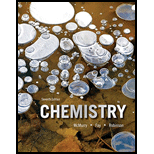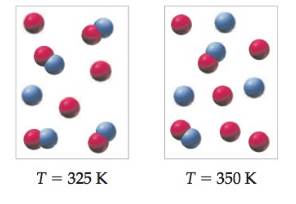
Chemistry
7th Edition
ISBN: 9780321940872
Author: John E. McMurry, Robert C. Fay, Jill Kirsten Robinson
Publisher: PEARSON
expand_more
expand_more
format_list_bulleted
Textbook Question
Chapter 14, Problem 14.45CP
The following pictures represent equilibrium mixtures at 325 Kand 350 K for a reaction involving A atoms (red), B atoms (blue),and AB molecules:

(a) Write a balanced equation for the reaction that occurs onraising the temperature.
(b) Is the reaction exothermic or endothermic? Explain usingLe Châtelier’s principle.
(c) if the volume of the container is increased, will the number ofA atoms increase, decrease, or remain the same? Explain.
Expert Solution & Answer
Want to see the full answer?
Check out a sample textbook solution
Students have asked these similar questions
For the condensation reaction between Alanine and histidine write the amididation reaction mechanism using arrows then write the three letter code for the product of the reaction and the one letter code for the product of the reaction.
Write the amididation reaction mechanism of p-aminophenol and acetic acid to produce acetaminophen please use arrows.
Name the following using IUPAC.
Chapter 14 Solutions
Chemistry
Ch. 14 - Prob. 14.1PCh. 14 - APPLY 14.2 Nitrogen dioxide, a pollutant that...Ch. 14 - Prob. 14.3PCh. 14 - APPLY 14.4 Lactic acid, which builds up in muscle...Ch. 14 - Conceptual PRACTICE 14.5 The following pictures...Ch. 14 - Conceptual APPLY 14.6 The equilibrium constant...Ch. 14 - PRACTICE 14.7 In the industrial synthesis of...Ch. 14 - APPLY 14.8 At 25 °C, Kp = 25 for the reaction...Ch. 14 - Prob. 14.9PCh. 14 - APPLY 14.10For the reaction...
Ch. 14 - Prob. 14.11PCh. 14 - APPLY 14.12 Magnesium hydroxide is the active...Ch. 14 - Prob. 14.13PCh. 14 - Prob. 14.14ACh. 14 - Prob. 14.15PCh. 14 - Conceptual APPLY 14.16 The reaction A2 + B2 2...Ch. 14 - PRACTICE 14.17 The H2/CO ratio in mixtures of...Ch. 14 - APPLY 14.18 Calculate the equilibrium...Ch. 14 - PRACTICE 14.19 Calculate the equilibrium...Ch. 14 - APPLY 14.20 Calculate the equilibrium...Ch. 14 - Prob. 14.21PCh. 14 - Prob. 14.22ACh. 14 - Prob. 14.23PCh. 14 - Prob. 14.24ACh. 14 - Prob. 14.25PCh. 14 - Prob. 14.26ACh. 14 - Prob. 14.27PCh. 14 - Prob. 14.28ACh. 14 - Prob. 14.29PCh. 14 - Prob. 14.30ACh. 14 - Prob. 14.31PCh. 14 - Prob. 14.32ACh. 14 - Prob. 14.33PCh. 14 - Prob. 14.34PCh. 14 - Prob. 14.35PCh. 14 - Prob. 14.36PCh. 14 - PROBLEM 14.37 The affinity of hemoglobin (Hb) for...Ch. 14 - Prob. 14.38PCh. 14 - Prob. 14.39CPCh. 14 - The following pictures represent the equilibrium...Ch. 14 - The reaction A2+BA+AB has an equilibrium constant...Ch. 14 - Prob. 14.42CPCh. 14 - Prob. 14.43CPCh. 14 - Prob. 14.44CPCh. 14 - The following pictures represent equilibrium...Ch. 14 - Prob. 14.46CPCh. 14 - Prob. 14.47CPCh. 14 - Prob. 14.48CPCh. 14 - Prob. 14.49CPCh. 14 - Prob. 14.50SPCh. 14 - Identify the true statement about the...Ch. 14 - Prob. 14.52SPCh. 14 - Prob. 14.53SPCh. 14 - For each of the following equilibria, write the...Ch. 14 - Prob. 14.55SPCh. 14 - Prob. 14.56SPCh. 14 - Prob. 14.57SPCh. 14 - For each of the following equilibria, write the...Ch. 14 - Prob. 14.59SPCh. 14 - 14.60 If Kc = 7.5 × 10-9 at 1000 K for the...Ch. 14 - Prob. 14.61SPCh. 14 - Prob. 14.62SPCh. 14 - Prob. 14.63SPCh. 14 - Prob. 14.64SPCh. 14 - Prob. 14.65SPCh. 14 - Prob. 14.66SPCh. 14 - Prob. 14.67SPCh. 14 - Prob. 14.68SPCh. 14 - Prob. 14.69SPCh. 14 - Prob. 14.70SPCh. 14 - Prob. 14.71SPCh. 14 - Prob. 14.72SPCh. 14 - Prob. 14.73SPCh. 14 - Prob. 14.74SPCh. 14 - Prob. 14.75SPCh. 14 - Prob. 14.76SPCh. 14 - Prob. 14.77SPCh. 14 - Prob. 14.78SPCh. 14 - Prob. 14.79SPCh. 14 - Prob. 14.80SPCh. 14 - Prob. 14.81SPCh. 14 - Prob. 14.82SPCh. 14 - Prob. 14.83SPCh. 14 - Prob. 14.84SPCh. 14 - Prob. 14.85SPCh. 14 - Prob. 14.86SPCh. 14 - Prob. 14.87SPCh. 14 - Prob. 14.88SPCh. 14 - Prob. 14.89SPCh. 14 - Prob. 14.90SPCh. 14 - Prob. 14.91SPCh. 14 - Prob. 14.92SPCh. 14 - Prob. 14.93SPCh. 14 - Prob. 14.94SPCh. 14 - Prob. 14.95SPCh. 14 - Prob. 14.96SPCh. 14 - Prob. 14.97SPCh. 14 - Prob. 14.98SPCh. 14 - Prob. 14.99SPCh. 14 - Prob. 14.100SPCh. 14 - Prob. 14.101SPCh. 14 - Prob. 14.102SPCh. 14 - Prob. 14.103SPCh. 14 - Prob. 14.104SPCh. 14 - Consider the endothermic reaction...Ch. 14 - Prob. 14.106SPCh. 14 - Prob. 14.107SPCh. 14 - Prob. 14.108SPCh. 14 - Prob. 14.109SPCh. 14 - Prob. 14.110SPCh. 14 - Prob. 14.111SPCh. 14 - Prob. 14.112SPCh. 14 - Prob. 14.113SPCh. 14 - Prob. 14.114SPCh. 14 - Prob. 14.115SPCh. 14 - Prob. 14.116SPCh. 14 - Prob. 14.117SPCh. 14 - Prob. 14.118SPCh. 14 - Forward and reverse rate constants for the...Ch. 14 - Prob. 14.120CPCh. 14 - Prob. 14.121CPCh. 14 - Prob. 14.122CPCh. 14 - Prob. 14.123CPCh. 14 - Prob. 14.124CPCh. 14 - Prob. 14.125CPCh. 14 - Prob. 14.126CPCh. 14 - Prob. 14.127CPCh. 14 - Prob. 14.128CPCh. 14 - Prob. 14.129CPCh. 14 - Prob. 14.130CPCh. 14 - At 1000 K, Kp, = 2.1 106 and H=107.7kJ for the...Ch. 14 - Prob. 14.132CPCh. 14 - Prob. 14.133CPCh. 14 - Prob. 14.134CPCh. 14 - Prob. 14.135CPCh. 14 - Prob. 14.136CPCh. 14 - Prob. 14.137CPCh. 14 - Prob. 14.138CPCh. 14 - Prob. 14.139CPCh. 14 - Prob. 14.140CPCh. 14 - Prob. 14.141CPCh. 14 - Prob. 14.142CPCh. 14 - Prob. 14.143CPCh. 14 - Prob. 14.144CPCh. 14 - Prob. 14.145CPCh. 14 - Prob. 14.146CPCh. 14 - Prob. 14.147MPCh. 14 - Prob. 14.148MPCh. 14 - Prob. 14.149MPCh. 14 - Prob. 14.150MPCh. 14 - Prob. 14.151MPCh. 14 - Prob. 14.152MPCh. 14 - Prob. 14.153MPCh. 14 - Prob. 14.154MPCh. 14 - Prob. 14.155MPCh. 14 - Prob. 14.156MPCh. 14 - Prob. 14.157MPCh. 14 - Prob. 14.158MPCh. 14 - Prob. 14.159MP
Knowledge Booster
Learn more about
Need a deep-dive on the concept behind this application? Look no further. Learn more about this topic, chemistry and related others by exploring similar questions and additional content below.Similar questions
- For the condensation reaction between Alamine and histamine, please help me write the amididation reaction mechanism. Then write the three letter code for the product of the reaction, then write the one letter code for the product of the reaction. arrow_forwardHow to draw the reaction mechasnism belowarrow_forwardName the following molecules with IUpacarrow_forward
- What is the molecular orbital for cyclopropenyl anion and is it aromatic, antiaromatic or nonaromatic?arrow_forwardUsing the chart describe the change from cystine to tyrosine and its impact on the protein. Using the chart describe the change from histidine to aspartic acid and its impact on the protein.arrow_forwardHow to get the predicted product of this reaction belowarrow_forward
- Please help me fill out the chart then using the chart describe the change from cystine to tyrosine and its impact on the protein. Then using the chart describe the change from histidine to aspartic acid.arrow_forwardWrite the Esterification reaction mechanism for acetic acid, and one propanol to make propanol ethanoate (molecule that gives peas its odor in flavor)arrow_forwardProvide solutionsarrow_forward
arrow_back_ios
SEE MORE QUESTIONS
arrow_forward_ios
Recommended textbooks for you
 General Chemistry - Standalone book (MindTap Cour...ChemistryISBN:9781305580343Author:Steven D. Gammon, Ebbing, Darrell Ebbing, Steven D., Darrell; Gammon, Darrell Ebbing; Steven D. Gammon, Darrell D.; Gammon, Ebbing; Steven D. Gammon; DarrellPublisher:Cengage Learning
General Chemistry - Standalone book (MindTap Cour...ChemistryISBN:9781305580343Author:Steven D. Gammon, Ebbing, Darrell Ebbing, Steven D., Darrell; Gammon, Darrell Ebbing; Steven D. Gammon, Darrell D.; Gammon, Ebbing; Steven D. Gammon; DarrellPublisher:Cengage Learning Chemistry: Principles and ReactionsChemistryISBN:9781305079373Author:William L. Masterton, Cecile N. HurleyPublisher:Cengage Learning
Chemistry: Principles and ReactionsChemistryISBN:9781305079373Author:William L. Masterton, Cecile N. HurleyPublisher:Cengage Learning Introductory Chemistry: A FoundationChemistryISBN:9781337399425Author:Steven S. Zumdahl, Donald J. DeCostePublisher:Cengage Learning
Introductory Chemistry: A FoundationChemistryISBN:9781337399425Author:Steven S. Zumdahl, Donald J. DeCostePublisher:Cengage Learning Introductory Chemistry: An Active Learning Approa...ChemistryISBN:9781305079250Author:Mark S. Cracolice, Ed PetersPublisher:Cengage Learning
Introductory Chemistry: An Active Learning Approa...ChemistryISBN:9781305079250Author:Mark S. Cracolice, Ed PetersPublisher:Cengage Learning ChemistryChemistryISBN:9781305957404Author:Steven S. Zumdahl, Susan A. Zumdahl, Donald J. DeCostePublisher:Cengage Learning
ChemistryChemistryISBN:9781305957404Author:Steven S. Zumdahl, Susan A. Zumdahl, Donald J. DeCostePublisher:Cengage Learning Chemistry for Engineering StudentsChemistryISBN:9781337398909Author:Lawrence S. Brown, Tom HolmePublisher:Cengage Learning
Chemistry for Engineering StudentsChemistryISBN:9781337398909Author:Lawrence S. Brown, Tom HolmePublisher:Cengage Learning

General Chemistry - Standalone book (MindTap Cour...
Chemistry
ISBN:9781305580343
Author:Steven D. Gammon, Ebbing, Darrell Ebbing, Steven D., Darrell; Gammon, Darrell Ebbing; Steven D. Gammon, Darrell D.; Gammon, Ebbing; Steven D. Gammon; Darrell
Publisher:Cengage Learning

Chemistry: Principles and Reactions
Chemistry
ISBN:9781305079373
Author:William L. Masterton, Cecile N. Hurley
Publisher:Cengage Learning

Introductory Chemistry: A Foundation
Chemistry
ISBN:9781337399425
Author:Steven S. Zumdahl, Donald J. DeCoste
Publisher:Cengage Learning

Introductory Chemistry: An Active Learning Approa...
Chemistry
ISBN:9781305079250
Author:Mark S. Cracolice, Ed Peters
Publisher:Cengage Learning

Chemistry
Chemistry
ISBN:9781305957404
Author:Steven S. Zumdahl, Susan A. Zumdahl, Donald J. DeCoste
Publisher:Cengage Learning

Chemistry for Engineering Students
Chemistry
ISBN:9781337398909
Author:Lawrence S. Brown, Tom Holme
Publisher:Cengage Learning
Chemical Equilibria and Reaction Quotients; Author: Professor Dave Explains;https://www.youtube.com/watch?v=1GiZzCzmO5Q;License: Standard YouTube License, CC-BY